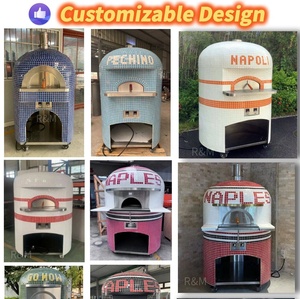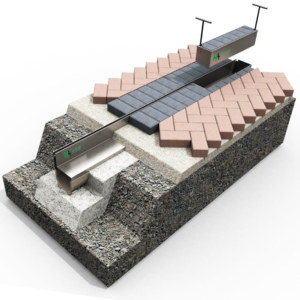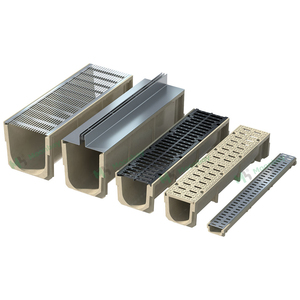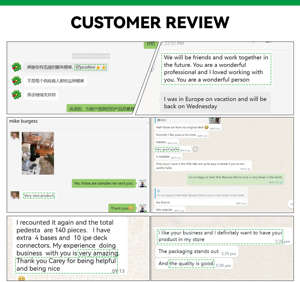
All categories
Featured selections
Trade Assurance
Buyer Central
Help Center
Get the app
Become a supplier

(3796 products available)































Precast concrete parts are specialized componentsCast in a controlled environment before being transported to the construction site for assembly. Common precast concrete parts include the
Precast Concrete Wall
The precast concrete walls, typically made of high-strength concrete, provide structural support and enclose building interiors. On the one hand, They can be erected quickly, saving construction time. On the other hand, their uniformity and quality control reduce on-site labor and variation. Precast walls can also integrate windows, doors, and insulation for energy efficiency and aesthetic appeal.
Precast Concrete Beam
The precast concrete beams function as horizontal supports for floors or roofs, spanning openings between vertical columns or walls. Common beam types include I-beams, T-beams, and hollow-core beams, which are chosen based on load requirements and architectural design. Precast concrete beams are manufactured using high-strength concrete. As a result, they possess sufficient load-bearing capacity to support the weight of the structure and any imposed loads. They are also precast in standard lengths and sizes to allow for easy replacement and inventory management.
Precast Concrete Column
Precast Concrete Columns are vertical structural elements that support beams or other horizontal members, typically made of high-strength concrete, The columns are manufactured off-site and then transported to the location for installation. Common types of Precast Concrete Columns include rectangular columns, round columns, and T-shaped columns, which are selected based on the specific structural requirements and architectural preferences of the project. They can be assembled quickly with minimal on-site labor, contributing to faster construction timelines.
Precast Concrete Slab
A precast concrete slab is a large, flat horizontal member used to make floors or roofs. It is manufactured by casting concrete in a reusable mold or slab that is pre-formed before installation. Precast concrete slabs are often used in commercial, industrial, and residential construction for their speed of installation and ability to provide a solid, level surface. Hollow core slabs, for example, are a type of precast slab with voids running perpendicular to the slab to reduce weight and material usage while maintaining strength.
While precast concrete parts don't need regular maintenance, some optional services might help keep them in good condition. It's a good idea to look closely at precast concrete pieces now and then, checking for any cracks, spalls, or signs of rust on embedded metals. If problems are found, consult an engineer or manufacturer immediately so repairs can be made before minor issues turn into significant ones. Optional periodic cleaning of exposed aggregate panels and polished precast components using non-ionic detergent solutions or warm water with a mild pH level may help maintain aesthetics over longer periods. Still, this should only be considered when the capacity for cleaning precisely and efficiently is present. Instead, always take proper care during installation, transport, and handling, as these are vital for longevity, too, along with avoiding exposure to harmful chemicals, de-icing agents, or high salt environments, which could compromise the quality of any precast material used for construction purposes.
Precast concrete parts are used in different industries and building projects because they are durable and flexible. Here are some common ways they are used:
Business buyers need to consider the following factors when choosing precast concrete parts such as concrete wall panels, concrete stairs, and concrete slabs:
Structural requirement analysis
Business buyers need to analyze the architectural requirement first. They need to factor in the project scale, load-bearing requirement, insulation needs, etc. This information will help business buyers choose precast concrete parts with the right size and structural features.
Design and customization option
Business buyers need to determine whether they want to choose the existing designs or if they want to collaborate with suppliers to create a unique design. Also, they need to determine whether they want to choose the standard precast concrete parts or ones that come with integrated features, such as built-in utility conduits or thermal insulation layers.
Logistics and assembly
Business buyers need to consider the ease of assembly and transportation. For example, if the project site is remote, the buyer may need to consider the logistics and choose precast concrete parts that are easier to transport.
Cost analysis
Business buyers need to perform cost analysis based on budget limitations and project requirements. In addition to the purchasing costs, business buyers need to consider additional expenses, such as transportation fees and assembly costs. They need to ensure that the final choice aligns with the budget but does not compromise project quality.
Sustainability options
If sustainability is a major concern for business buyers, they may need to choose precast concrete parts that can improve projects' energy efficiency, such as panels with insulation or translucent elements. Additionally, business buyers can also opt for precast concrete parts made with eco-friendly materials or manufacturing processes.
Supplier assessment
In the end, business buyers need to assess potential suppliers. They may consider factors, such as the supplier's manufacturing capacity, quality assurance system, customization ability, and delivery schedule. Choosing a reliable supplier can ensure that the precast concrete parts will meet the project's requirements and the buying experience will be smooth.
Q1: What is the life of precast concrete?
A1: With proper maintenance and care, precast concrete structures can last for a century or more.
Q2: What are the disadvantages of precast concrete?
A2: The disadvantages include transportation costs and the need for that large temporary works to cast the elements.
Q3: What is the future of precast concrete?
A3: The future of precast concrete looks promising. The available have made precast concrete more accessible and cheaper.
Q4: Can precast concrete be repaired?
A4: Yes, precast concrete can be repaired. Cracks in the panels can be filled with epoxy, but it is better to avoid the panel from cracking.